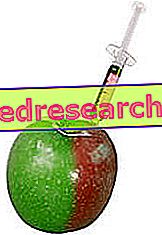Edited by Eugenio Ciuccetti, Obstetrician
Don't eat for two!
Speaking of nutrition during pregnancy means paying attention to the quantity, quality and distribution of the food consumed, and of the meals served, during the nine months of gestation.

In the same way it is absolutely incorrect to put concerns of a purely aesthetic nature before the well-being of oneself and one's child. Pregnancy, it is true, involves intense modifications for the woman's body. Many of which, however, are reversible. Knowing how to accept and manage them in a natural way will also mean that they can then be reabsorbed just as quickly, effectively and physiologically.
Pregnancy Weight Control
Let's start with remembering and underlining some fundamental rules to follow, and some basic criteria to be respected.
Initial assessment and calculation of weight gain
For example, you must first pay attention to the initial - pre-pregnancy - measures of the pregnant woman and calculate her body mass index or Body Mass Index. The formula to use is very simple. Just divide your weight by your height squared. In other words, let's assume we are dealing with a certain Mrs. Maria. And let's say that, at the beginning of the nine months of pregnancy, you measure 170 centimeters in height by 65 kilograms of weight. The calculation to be performed will be 65 divided by 2.89 (ie 1.70 squared). The result will be 22.49, therefore included in the standard interval between 19.8 and 26. This means that Mrs. Maria has a normal body mass index (it will be defined as "normal weight") and that during the nine months of pregnancy can physiologically increase between 11.5 and 16 kilograms.
If her body mass index had instead been lower than 19.8, Ms. Maria would have been called "thin" or - especially in the case of values below 18.5 - even "underweight". For her a weight increase in pregnancy between 12.5 and 18 kilograms would therefore be considered physiological.
On the contrary, a lady who started her gestation with a body mass index between 26 and 29 should try to limit her weight growth during the nine months between 7 and 11.5 kilograms. Finally, a woman who has a body mass index of more than 30 before becoming pregnant (therefore tending to obesity) should not increase more than 7 kilograms during pregnancy.
Calculation of Pregnancy Weight Gain
The following calculation form allows to obtain an evaluation of one's current weight, an estimate of the weight increase associated with pregnancy and a general indication of the caloric intake recommended during gestation.
Importance of Proper Weight Control
Those supplied are, of course, indicative data, which nevertheless apply as a reference and highlight a very important theoretical concept: weight gain during pregnancy cannot and must not be left to chance. This is for the wellbeing of both mother and child, therefore for the healthy development of pregnancy, childbirth and the subsequent puerperium.
Increasing excessively weight in pregnancy, in fact, does not mean so much to change from an aesthetic point of view, but above all to determine possible complications such as tedious lumbosciatia of the mother in the third trimester (when the problems of posture and walking inevitably become more consistent) or favor the birth of macrosomic children (with the consequent risk of lacerations, fetal distress, operating parts, etc.).
Likewise, an insufficient or incomplete diet can cause other problems, such as premature births, hence the birth of underweight babies, underdeveloped or even abortions.
Pregnancy Weight Trend
The second concept to be stressed refers to the distribution - physical and temporal - of the kilos that the woman comes to buy during the forty weeks in question. Meanwhile, it should be remembered that weight gain is much more significant in the second half of pregnancy (from the twentieth week onwards). Therefore, having maintained a good weight in the first twenty weeks must not become the pretext for letting go in the next phase.
We must also keep in mind that this weight gain is not attributable solely to a corresponding increase in body fat but also to many other factors: the fetus, for example, which at the end of gestation will weigh about three and a half kilos on the scale. And again the amniotic fluid in which it is immersed and naturally the placenta which, by itself, will weigh about 500 grams.
In addition, most pregnant women will have to deal with more or less intense problems of water retention, therefore with edema and swelling, especially in the lower limbs; however annoying, these represent the inevitable and necessary effect of the hormonal transformations typical of this phase. We are not talking about the equally physiological increases that will affect the uterus, the breast and the same circulating blood.
Weight Recovery During Lactation and Puerperium
However, the positive figure, if we wish to define it, concerns post-partum. Obviously the pounds due to the fetus and appendages such as the placenta will be lost immediately after the baby is born. In the same way, except for particular pathological conditions, water retention problems will be disposed of rather quickly.
Instead, the real kilos of fatty tissue accumulated during pregnancy will be "reabsorbed". This is why a controlled increase in weight during gestation will also make the subsequent recovery more simple and painless.

Puerperium and breastfeeding are delicate phases, which require - both from a nutritional point of view and physical activity - tranquility and attention. At the same time, pregnancy and childbirth will have put the woman's body to the test and, in particular, some of her more delicate structures, such as the pelvic floor.
Rashly undergoing premature and improper training, for example at the level of the abdominal muscles, means getting hurt, risking to favor the subsequent appearance of significant problems such as prolapses and urinary incontinence. As we say, then, much better prevention than cure.
What to eat?
Coming back to the front of our reasoning, we underline that in pregnancy it is necessary:
- feed properly,
- keep your weight changes constantly under control (knowing how to recognize and interpret them)
- carry out adequate preparatory physical activity (which we will talk about elsewhere).
Naturally, in this context, the help and competence of the operators who assist the woman will be precious, sometimes indispensable: from the gynecologist to the midwife, up to the nutritionist.
But first and foremost it will be the future mother who has to document herself, putting her awareness and responsibility to work in everyday life.
How many calories?
For example it is important to keep in mind that the woman's energy needs, during pregnancy, will increase proportionally to her starting form conditions.
So - based on the criteria seen previously - if this is classified as "normal weight", its additional energy demand will be around 250 Kcal per day. If, on the other hand, we are dealing with an underweight woman, this contribution can increase up to 350 Kcal. Finally, if the woman starts overweight gestation, her caloric needs should not exceed 200 Kcal per day.
Obviously each of these general data will then have to be calibrated more precisely based on the specific individual characteristics of the person in question; for example evaluating how much this is actually over or under weight; and again how much and what physical activity it performs during the nine months of pregnancy. Proper nutrition should in fact always be accompanied by proper physical exercise.
It should also be remembered that these calories will serve both to provide energy to the mother, and to the growth of its tissues such as the uterus and the placenta than to the development of the fetus. The latter, in the third quarter, will need around 100 / Kcal for each kilogram of weight. Therefore, even at the end of pregnancy, he will not need more than 350 Kcal per day. More or less the caloric equivalent of two or three yoghurts and certainly not pizzas, cakes or french fries.
In fact, beyond the simple counting of calories, it will in fact be fundamental to qualitatively guarantee the unborn child all the essential substances for his healthy training and his complete development.
Important foods and nutrients
A correct diet will be a varied, balanced and nutritious diet.
For example, the proteins obtained from meat, fish, eggs and poultry, but also from legumes and soy will be used.
Serve the carbohydrates that are our main source of energy, but avoid overdoing with bread, sweets and sugar. And yet the vitamins we can get from fruits and vegetables; for example vitamin C - contained in citrus fruits, strawberries and broccoli - effective against infections and useful for iron absorption; minerals such as zinc and magnesium; dairy products, rich in calcium - indispensable for bones, teeth and muscles - as well as being precious for breastfeeding.

The important thing, both in terms of nutrition and hydration, will be to distribute food and drink in a balanced way throughout the day. Don't overeat in a single meal or drain a liter of milk all at once. Rather, eat and drink little but often. For example, three main meals and a couple of snacks, mid-morning and mid-afternoon. The same applies to the intake of liquids, with a healthy glass of water always ready at your side, without necessarily waiting for your mouth to be dry.
Where and when possible it will also be advisable to consume organic and fresh foods - both for meat and fish and for fruit and vegetables - rather than frozen foods.
Avoid sweeteners, preservatives and dyes. Pay attention to the information contained on the labels of the different products, their composition and their nutritional values. Pregnancy, after all, can also become an opportunity to discover and experiment with new and healthy dishes and to change one's incorrect daily habits. Try for example, if you are not already part of your usual diet, supplement your meals with new elements such as almonds, walnuts, seaweeds and sprouts. You could give your palate - as well as your body - some pleasant surprises.
See also: Example Diet in Pregnancy »
Finally, remember to respect some essential hygienic and behavioral rules such as carefully washing your hands before cooking, never taking expired foods even if they are apparently still edible, avoiding drinks that contain caffeine, and as far as possible consume your meals calmly, in a quiet environment, chewing slowly. Leaving aside all your other worries for at least a few minutes.
Foods to avoid
- Soft / semi-soft cheeses with crust and mold (eg gorgonzola, brie).
- Raw minced meat or raw sliced meat (carpaccio)
- Fresh salami (sausage) or slightly seasoned salami (hunter).
- Family productions (for women who are negative for the diagnosis of toxoplasmosis).
- Raw fish (sushi, sashimi, etc.)
- Salads ready at the bar or in gastronomy.
- Raw milk purchased from distributors or breeder (eat only after boiling).
- Raw or undercooked eggs.
Additional Advice
- Vegetables, even those already packed, should be consumed only after careful washing.
- Do not exceed, for swordfish, shark, verdesca, tuna, a weekly portion in order to avoid the accumulation of possible pollutants such as mercury.
- Wash hands after handling raw meat or eggshell.
- Consume zabaglione, mayonnaise, creams and homemade tiramisu with strictly pasteurized eggs within the next day.



